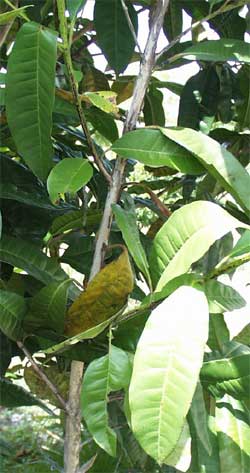Excerpts from Jim Conrad's
Naturalist Newsletter
from the November 30, 2005 Newsletter written at Hacienda San Juan Lizarraga one kilometer east of Telchac Pueblo, Yucatán, MÉXICO
and issued from Hotel Reef Yucatan 13 kms to the north
ALLSPICE
Each morning I greet Roberto the gardener with a "¿Qué hay de nuevo?" or "What's new?" and one day this week he had something new. During his machete work on the hacienda's grounds he'd come across a 20- ft-high tree he couldn't recognize. Roberto knows a lot, so I figured he had a good find.
The tree's leathery, six-inch-long leaves were simple, unlobed, with smooth margins, and with typical pinnate venation. In other words, they were about the most ordinary-looking leaves imaginable. However, then I began noticing details.

First, the leaves arose from the stems in pairs, not singly, which by far is the most common state. The tree's buds were not covered with scales -- they were "naked." Holding a leaf up to the sun, its surface seemed to be densely set with almost-microscopic pinpricks -- botanists would call such a leaf- surface's condition "pellucid-punctate." The punctations consisted of translucent glands embedded in the leaf matrix, filled with aromatic oils. Because my fingers were crushing some of the glands a delightful fragrance suffused the air around me, an effervescently fresh scent very like clove.
It was an Allspice tree, PIMENTA DIOICA, a member of the fabulous Myrtle Family, in which we also find such spicy-smelling trees as the eucalyptuses, the Clove-tree and the classic Myrtle, as well as guava trees. That's it at the righ.
Allspice spice is made from this tree's small, dried, unripe berries. It's said that the odor of allspice spice is like a rich blend of cinnamon, nutmeg and cloves. While the Myrtle Family does produce cloves, trees providing cinnamon and nutmeg belong to the Laurel Family in which our eastern US Sassafras also is found.
Why would plants evolve smelling so good? If you could have seen the leaves of our Allspice tree maybe a good answer would have occurred to you as it did to me. Those leaves were practically unblemished by bug munchings and fungal infections. All surrounding trees bore leaves that now at the end of the rainy growing season were tattered and spotted, but the Allspice's leaves were still in mint condition.
The aromatic oils in those pellucid punctations must taste awfully bitter to bugs.